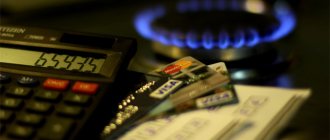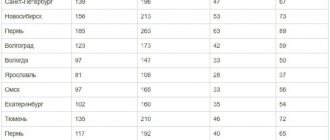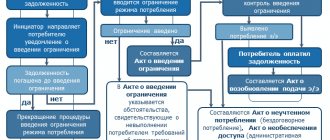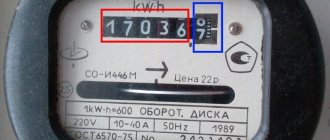Electricity consumption of household appliances: table and tips for saving
The annual increase in the cost of electrical energy forces users to think about methods of controlling its consumption and ways to save. The instructions for any equipment indicate the power of the device. However, this is an average value and may vary depending on certain factors. You can learn how to correctly calculate the electricity consumption of household appliances from this article.
The more appliances you use in your home, the higher your energy costs will be.
Total power in W: how much energy do household appliances consume in kW
Any apartment is equipped with the necessary set of household appliances and electrical equipment. Each type of equipment has individual technical characteristics, including power and energy consumption. The total value of all these factors determines the total amount of electrical energy consumed, which will be different for each family.
Distribution of energy consumption by electrical appliances as a percentage.
In order to plan possible expenses, some owners resort to compiling a table of electricity consumption by household appliances per hour, where they indicate the name of the consumer, its power and duration of operation throughout the day. Information about the total energy consumption of household appliances and lighting elements is necessary for installing switching and protective equipment and selecting the cross-section of electrical wiring.
On a note! To determine the total power, the corresponding consumer values must be converted into one unit of measurement, so it is important to know how many W are in 1 kW.
From the table below you can conclude which household appliances consume more electricity. These include a lighting system, refrigerator, TV, computer, washing machine, electric kettle and iron. The total value averages 120-180 kW per month. Additional costs include the use of small household appliances in the form of a hair dryer, coffee maker, food processor, chargers and other elements that provide the required level of comfort. In the summer, the use of air conditioning is also taken into account, and in winter - oil electric heaters, which add 60-100 kW.
Electricity metering
An electric meter is a special device for metering alternating current electricity. There are such meters in every home, and they count not kilowatts or amperes, but kilowatt-hours. So, a kilowatt-hour is a non-system unit of measurement that demonstrates how much power in kilowatts an electrical appliance consumes in 1 hour of operation. It is for the kilowatt-hours that the meter registers that we pay the electricity producer. We can independently estimate the average daily electricity consumption in order to plan our spending on utilities.
Energy consumption table for household appliances
For each home, the number of electrical devices, the value of their electricity consumption and the duration of operation will be different. The table below for energy consumption of household appliances contains average information:
| Device name | power, kWt | Operating time per day, h | Consumption per day, kWh | Consumption per month, kWh |
| Fridge | 0,15-0,6 | 24 | 3,6-8,6 | 10,8-25,8 |
| Lighting (10 lamps 20 W each) | 0,020 | 5 | 0,1 | 3 |
| Washing machine | 1-2,2 | 1 | 1-2,2 | 20-30 |
| Vacuum cleaner | 0,65-2,2 | 15 minutes | 0,16-0,55 | 1,6-5,5 |
| TV | 0,1-0,3 | 5 | 0,5-1,5 | 15-30 |
| Microwave | 1,5 | 30 minutes | 0,75 | 10-15 |
| Electric kettle | 0,7-3 | 15 minutes | 0,25-0,75 | 7,5-16,5 |
| Computer | 0,1-0,2 | 5 | 0,5-1 | 7-20 |
| Iron | 1,1 | 15 | 0,3 | 5-8 |
| Dishwasher | 0,5-2,8 | 1 | 0,5-2,8 | 7,5-15 |
| Multicooker | 0,2-2,4 | 1 | 0,2-2,4 | 2-24 |
| Food processor | 0,2-2,0 | 15 minutes | 0,05-0,5 | 0,5-3 |
| Air conditioner | 0,7-1,3 | 7 | 3,5-8 | 15-35 |
| Hairdryer | 1,2-1,5 | 15 minutes | 0,3-0,4 | 5-7 |
| Heater | 1,5 | 5 | 7,5 | 75 |
| Electric stove | 2-8,5 | 3 | 5-10 | 30-150 |
| Coffee maker | 1,5-3,5 | 15 minutes | 0,3-0,8 | 5-10 |
| Hood | 0,1-0,5 | 3 | 0,3-1,5 | 3-4,5 |
Table of electricity consumption by main electrical appliances by power
Power indicators of electrical appliances will help you make calculations, develop a rational approach to energy consumption and save money. The table shows the average power indicators indicated in the technical data sheets of devices used in citizens’ apartments:
| electrical appliance | Power, W |
| Appliances | |
| Fridge | 300 |
| Lighting lamps | 20 – 250 |
| Electric stove | 7000 |
| Electric shaver | Up to 100 |
| Dishwasher | 2500 |
| TV (plasma, LCD, LCD, etc.) | 70 – 200 |
| Washing machine | 1500 – 3000 |
| Electric oven | 1000 – 4000 |
| Iron | 2000 |
| Electric kettle | 1600 – 2000 |
| Oil heater | 800 – 2500 |
| Microwave | 800 |
| Air fryer | 1200 – 2000 |
| Home fan heater | 750 – 1700 |
| Hairdryer | 450 – 2000 |
| Coffee maker, coffee machine | 600 – 1500 |
| Air conditioner | 2000 |
| Mobile phone charger | 25 |
| Vacuum cleaner | 400 – 2000 |
| Multicooker, steamer | 800 – 2000 |
| Computer | 250 |
| Laptop | 80 |
| Music Center | 50 – 500 |
| Food processor | 200 – 1500 |
| Meat grinder | 230 – 3000 |
| Blender | 180 |
| Freezers, chambers | 1500 – 5000 |
| Game console | 10 – 30 |
| Boiler | 1200 – 1500 |
| Electric tool | |
| Hammer | 600 – 1400 |
| Jigsaw | 250 – 700 |
| Drill | 400 – 800 |
Refrigerator: how many watts does it consume per hour?
When answering the question of which electrical appliances consume the most energy, the refrigerator will be first on the list. This device works around the clock. The actual energy consumption of the refrigerator is calculated taking into account the international classification of energy efficiency devices. This parameter is designated by a letter with a certain number of pluses; the more there are, the lower the level of electricity use.
The classification of a household appliance by energy efficiency is as follows:
- A++ - the highest class with maximum energy saving. Electricity consumption is 30% of the standard value;
- A+ - energy consumption - 30-42% of the standard;
- A - energy consumption - 42-55% of the standard;
- B - energy consumption - 55-75% of the standard;
- C – energy consumption – 75-90% of the standard;
- D – energy consumption – 90-100% of the standard;
- E - energy consumption - 100-110% of the standard;
- F - energy consumption - 110-125% of the standard.
However, the energy efficiency parameter is very average. Since the amount of electricity consumed by the refrigerator is affected by its operating mode, workload, and the number of door openings.
The refrigerator consumes the most energy of any electrical appliance.
On a note! The instructions for the refrigerator indicate the energy efficiency class and the amount of electricity it consumes per hour.
Annual energy consumption corresponds to 220-460 kW. It is impossible to obtain an accurate result for a table of electricity consumption per day or month by simply dividing this value. Since energy consumption is influenced by a number of factors, such as freezing power, ambient temperature, and product filling level.
To reduce the energy consumption of the refrigerator, it is necessary to operate the device correctly, do not leave the internal space empty when it is turned on, do not open the door for a long time, do not put hot food in, check the condition of the seals, ensure that there is a gap between the refrigerator and the wall, regularly defrost, wash and dry the unit.
Which devices really suck energy in standby mode?
Transformer chargers do waste electricity. But in everyday life, such power supplies are not often found and it is unlikely that anyone would think of leaving them in the outlet. What comes to mind is a charger for a car battery, a power supply for an LED strip, a power supply for a laptop and a charger for AAA batteries. Modern lightweight charging transformers do not have transformers in their design.
But the computer took 1.3 watts from the network when turned off, the 23″ monitor took 0.8 watts. The microwave in standby mode consumes as much as 1.6 watts for the glowing clock, which I still can’t set up (and after measuring it, I still unplugged it...).
We don’t keep televisions; devices with a remote control or a so-called “soft” start - they eat quite well. Plus these annoying LEDs are everywhere, which also need energy.
A multicooker in standby mode consumes 1.4 watts, a gas double-circuit boiler consumes 2 watts.
The electricity consumption in standby mode for the kettle, toaster and table lamp is zero, and I don’t see the point in checking the refrigerator, no matter how much you “eat” - you can’t get anywhere.
How to calculate your TV's electricity consumption
A TV is an essential element of household appliances in every home. Often, owners install several copies for each room. Devices can be of several types: cathode ray tube models, LED, LSD or plasma TVs. The power consumption of a device is affected by its type, screen size, color, brightness, white and black balance, active operation time, and duration of sleep mode. Based on the table of electricity consumption by household appliances, a TV uses an average of 0.1-0.3 kW.
Electrical energy consumption will depend on the type and operating mode of the TV.
The power of TVs in Watts with a cathode ray tube is 60-100 W per hour. On average he can work about 5 hours a day. Monthly consumption reaches 15 kW. This is how much electricity will be spent on its active operation. The TV also consumes 2-3 watts per hour in standby mode when plugged in. Total energy consumption can be 16.5-17.5 kW per month.
The energy consumption of LED or LSD models directly depends on the screen size. For example, an LSD TV with a 32-inch screen diagonal will consume 45-55 W per hour in operating mode, and 1 W in standby mode. The total electricity consumption per month is 6.7-9 kW. LED models consume on average 35-40% less electrical energy. In active mode, a 42-inch TV will use 80-100 W, in sleep mode - 0.3 W. Total consumption per month will be 15-20 kW.
Plasma TVs have good color reproduction. The TV power in kW is 0.15-0.19 in active mode, and 120 W/day in sleep mode. The total consumption per month can be 30-35 kW. To save energy, you should remove the plug from the socket, correctly adjust the brightness level depending on the time of day, and set the timer to automatically turn off.
Electric vehicle energy consumption
For lucky owners of electric vehicles, the amount in the receipt for light will increase significantly. Note that if you charge your car exclusively at home, without using the services of gas stations, you can reduce the cost of “refueling” by up to 2.5 times. How much does an electric car consume? Let's look at the example of the Nissan Leaf model.
The battery capacity of this car is 30 kW (24 kW is also available), which, according to the manufacturer, allows you to drive up to 160 km. The average Muscovite travels about 40 km per day, which is about a quarter of the Nissan Leaf battery charge. It turns out that you need to charge the battery once every four days, which is 7.5 * 30 = 225 kW per month. Per year this will be 225 * 12 = 2700 kW. For a Muscovite with a three-phase meter and a tariff the same as for an apartment with a gas stove, the cost of “refueling” an electric car will be: 2700 * 5.56 = 15,012 rubles/year. If you are not from Moscow, you can multiply by your tariff and get the amount.
Washing machine operation: how many kilowatts does the device consume?
To calculate how many watts a washing machine spends on one wash cycle follows from the calculation of its brand, model and technical characteristics. Energy is spent on the operation of the electric motor, which can be in the range of 400-800 W, heating element - 2 kW, pump for draining water - 40 W, control system in standby mode - 3-10 W. This indicator directly depends on power consumption.
The higher the temperature the washing mode provides, the higher the energy consumption will be.
The washing mode also affects the total consumption. The lower the water temperature, device operating time and speed, the less electricity the machine will consume. Washing machines have an energy consumption class, which determines the required amount of electricity:
- class A+ - energy consumption 0.17 kWh;
- class A – 0.17-0.19 kWh;
- class B – 0.19-0.23 kWh;
- class C – 0.23-0.27 kWh;
- class D – 0.27-0.31 kWh;
- class E – 0.31-0.35 kWh;
- class F – 0.35-0.39 kWh;
- class G – more than 0.39 kWh.
Based on the class, model, mode, load and water temperature, the machine consumes 300-1600 Wh per washing cycle.
In order to reduce the amount of electricity consumed, it is necessary to choose the optimal mode, which will depend on the degree of soiling of the laundry and its composition. A significant part of the electricity is spent on heating water and spinning. The machine should be fully loaded, since the units cannot determine the relationship between the amount of laundry and the value of electricity consumption per cycle. The machine should be cleaned at least once every six months using special products.
Many washing machine models have water and energy saving modes.
Methods for determining the electricity consumption of household appliances and tools
The average electricity consumption in citizens' apartments per month is the sum of the total electricity consumption of all electrical appliances used by its residents. Knowing the electricity consumption for each of them will give an understanding of how rationally they are used. Changing the operating mode can provide significant energy savings.
The total amount of electricity consumed per month in an apartment or house is recorded by the meter. There are several ways to obtain data for individual devices.
A practical way to calculate electricity consumption based on the power of an electrical appliance
The average daily electricity consumption of any home appliance is calculated using the formula; just remember the basic characteristics of electrical appliances. These are three parameters - current, power and voltage. Current is expressed in amperes (A), power in watts (W) or kilowatts (kW), and voltage in volts (V). From the school physics course, we remember how electricity is measured - it is a kilowatt-hour, it means the amount of electricity consumed per hour.
All home appliances are equipped with labels on the cable or on the device itself, which indicate the input voltage and current consumption (for example, 220 V 1 A). The same data must be present in the product passport. Based on current and voltage, the power consumption of the device is calculated - P=U×I, where
- P – power (W)
- U – voltage (V)
- I – current (A).
We substitute the numerical values and get 220 V × 1 A = 220 W.
Next, knowing the power of the device, we calculate its energy consumption per unit of time. For example, a regular liter electric kettle has a power of 1600 W. On average, he works 30 minutes a day, that is, ½ hour. We multiply the power by the operating time and get:
1600 W × 1/2 hour = 800 W/h, or 0.8 kW/h.
To calculate costs in monetary terms, we multiply the resulting figure by the tariff, for example, 4 rubles per kWh:
0.8 kW/h×4 rub.=3.2 rub. Calculation of the average monthly fee - 3.2 rubles * 30 days = 90.6 rubles.
In this way, calculations are made for each electrical appliance in the house.
Counting electricity consumption using a wattmeter
The calculations will give you an approximate result. It is much more reliable to use a household wattmeter, or energy meter - a device that measures the exact amount of energy consumed by any household device.
Digital wattmeter
Its functions:
- measuring power consumption at a given moment and over a certain period of time;
- current and voltage measurement;
- calculation of the cost of consumed electricity according to the tariffs you have set.
The wattmeter is plugged into a socket and the device you are going to test is connected to it. The display shows power consumption parameters.
Current clamps allow you to measure the current and determine the power consumed by a household appliance without disconnecting it from the network. Any device (regardless of manufacturer and modification) consists of a magnetic circuit with a movable disconnect bracket, a display, a voltage range switch and a button for recording readings.
Measurement procedure:
- Set the desired measuring range.
- Open the magnetic circuit by pressing the bracket, place it behind the wire of the device under test and close it. The magnetic core must be located perpendicular to the power wire.
- Take readings from the screen.
If a multi-core cable is placed in the magnetic core, the display will show zero. This happens because the magnetic fields of two conductors carrying the same current cancel each other out. To obtain the required values, measurements are carried out on only one wire. It is convenient to measure energy consumption through an extension cord-adapter, where the cable is divided into separate cores.
Determining energy consumption using an electric meter
A meter is another simple way to determine the power of a household appliance.
How to count light using a meter:
- Turn off everything in the apartment that runs on electricity.
- Record your readings.
- Plug in the desired device for 1 hour.
- Disable it and subtract the previous readings from the received numbers.
The resulting number will be an indicator of the electricity consumption of the individual device.
Electricity consumption of an electric stove
Electric stoves are very popular among consumers. The amount of electricity consumed by a device is affected by the type of hob, which can be induction or heating element, the diameter of the burners, the power and functionality of the device.
On a note! An induction surface consumes less electricity compared to an electric one.
The power of a household appliance directly depends on the number of burners and their diameter, which can be 14.5; 18 and 20. Accordingly, energy consumption is 1; 1.5 and 2 kW.
The oven power corresponds to 1.8-4 kW. The minimum energy consumption with one operating burner is 1 kW. The maximum power of an electric stove is calculated taking into account the number of simultaneously operating burners and the operating mode of the oven. It can be 5-8.5 kW, as can be seen from the table of the power of household appliances and their energy consumption.
To save energy when operating an electric stove, you should follow some recommendations:
- it is necessary to choose the correct diameter of the pan for a specific burner;
- It is better to use dishes with a flat bottom;
- To save heat loss, the pan should be covered with a lid.
By following simple cooking rules, you can save energy consumption on your electric stove.
Energy consumption
Calculating energy consumption for a house or apartment is not particularly difficult. To do this, you need to perform the following algorithm of actions:
- make a table of all electrical appliances used in the house, including lighting lamps;
- put in separate columns: device power, operating hours per day;
- for each energy consumer, calculate (by multiplying the power by the operating time) the average daily consumption;
- sum up all the obtained power values.
Such a calculation will give a real picture of electricity consumption. Using this data, you can control consumption and adjust the daily power consumption of each device.
It does not matter how power consumption is calculated or measured. The main task of the process is to correctly select the cross-section of conductors for wiring, supplying power cables and ensure that automatic protection is triggered
The cable supplying voltage to the room must withstand the simultaneous switching on of all consumers located in it for a long time. Its choice directly depends on the accuracy of determining the power of consumers.
How much does an electric boiler consume?
Electric boilers are installed in houses for heating and water heating. However, the simplicity of the design and ease of operation hides high energy consumption. Models of electric boilers differ in power, design, number of circuits and method of heating the coolant (heating elements, electrode or induction heating). Double-circuit boilers are used for heating and water heating. Boiler models are more economical than flow-through ones.
The choice of boiler is made on the basis of the required power that it must have to ensure heating of premises of a given area. When calculating, it should be taken into account that kW is the minimum power of the device required to heat 10 sq.m. of room area. Additionally, climatic conditions, the presence of additional insulation, the condition of doors, windows, floors and the presence of cracks in them, and the thermal conductivity of walls are taken into account.
Note! The final power of an electric boiler is influenced by the method of heating the coolant, while electrode devices are able to heat a large area while consuming less electricity.
To determine the electricity consumption of an electric boiler, it is necessary to calculate its operating mode. It should be borne in mind that the device will operate at full capacity for half the season. The duration of its operation per day is taken into account. Thus, to determine the total electricity consumption per day, it is necessary to multiply the number of hours by the power of the device.
Double-circuit boilers consume electricity in both winter and summer.
To reduce the cost of energy consumption of the boiler, you should install a two-phase meter, according to which electricity is calculated at night at a reduced tariff. It will also save money by using an automatic control device for electrical appliances, which will control the operation of the device based on the time of day.
What expenses does this add up to over a year - simple calculations for saving
To understand how much the devices “heat” their owner, you need to analyze the electricity consumption rates, and then calculate how much time per day the switched off units continue to “eat” money.
The total annual energy consumption of certain types of appliances and devices, expressed in money, is given in the last column of the table.
| No. | Consumer name | Average electricity consumption, W/hour | The amount that will have to be paid for downtime per year, Russian rubles |
| 1 | Electric coffee maker | 4-6 | 105,80-158,70 |
| 2 | Microwave oven (no grill) | 6 | 158,70 |
| 3 | LCD TV | 11-16 | 290,95-423,20 |
| 4 | LED TV | 1-2 | 26,45-52,9 |
| 5 | Personal computer (system unit) | 1-3 | 26,45-79,35 |
| 6 | LCD monitor | 1 | 26,45 |
| 7 | Laptop charger (without consumer) | 15 | 396,75 |
| 8 | Laptop charger left on the wire | 20-30 | 529,00-793,50 |
| 9 | Phone charger, smartphone | 2-3 | 52,90-79,35 |
Please note that the calculation in the last column is based on:
- the downtime of the “devourers” is equal to 8 hours;
- total number of days in a year (365);
- the cost of 1 kW/hour, equal to 4.53 Russian rubles (taken from a simple meter).
If you expand the list of home appliances, take into account the actual time they spend in standby mode, calculate the cost of a kilowatt at the correct tariff, and then add up all the “empty” costs, then the final amount may not be so harmless.
We hope that now you understand where the readings on the electricity meter come from, and you will also be able to save your money by disconnecting passive consumers from the network.
Air conditioner power consumption
The electricity consumption of an air conditioner directly depends on its operating mode. The device converts temperature using a heat pump, the operation of which is ensured by pumping a coolant, freon, with a compressor and changing the pressure in the lines. The coolant, depending on its operating mode (cooling or heating), passes from liquid to gaseous state in the outdoor or indoor unit.
The device goes into standby mode after reaching the set temperature. When it goes beyond the established standards, the air conditioner starts working again. The split system operates periodically, without consuming electricity in standby mode. Most of the energy is spent on operating the compressor and then the fan.
The air conditioner is selected based on its heating output, which is calculated in British thermal units. Converted to kilowatts, the following values are obtained:
- 7 – 2 kW;
- 9 – 2.5 kW;
- 12 – 3.5 kW;
- 18 – 5 kW.
The amount of energy consumed by an air conditioner will depend on the time of year and the room temperature.
On a note! To select an air conditioner based on heat output, you need to divide the area of the room by 10.
Thermal power should not be confused with electrical power. To calculate electricity consumption per hour, you should divide the cooling capacity by 3. As the above table of power consumption of household electrical appliances suggests, air conditioners consume 0.7-1.3 kW per hour of active operation, which depends on the type of compressor.
Is it possible to calculate electricity consumption knowing the approximate power
When making your own calculations, do not forget about the small power that some devices consume even when they are not working, but are connected to an outlet. It also needs to be counted. Many appliances are equipped with an indicator, or they have an LED, which can also consume some power.
Calculations are made as follows:
When calculating power according to the formula, you get an approximate value. In the case when you need an accurate indicator of power, it is better to use a wattmeter. Any power, be it electrical, thermal or mechanical, is measured in watts
In order to be able to save energy, it is important to know their power consumption by devices. To calculate the difference between two powers, subtract one such value from the other.
When you pay your electricity bill, you are essentially paying for every kilowatt you use. To convert watts to kilowatts, you need to divide one watt reading by 1000, and then multiply the resulting kilowatt value by the number of hours worked by the device. As a result, you will get the required value, existing as (kWh). If you multiply it by the cost of 1 kilowatt of electricity, you can find out how much you will have to pay to operate the device. For example, if there are only 10 light bulbs in your house or apartment and 100 W is the power consumed by each lamp, then after calculating we will get 10 x 100, resulting in 1000 W - the total power of all lamps. If you divide 1000 W by 1000, you get 1 kW. Now it is not difficult to calculate that if the light bulbs burned for 2000 hours a year, and one kilowatt per hour costs 6 rubles. Then, for a year you will have to pay 12,000 rubles.
How much electricity does a kettle consume?
An electric kettle is a convenient household appliance that can provide its owners with boiling water in a matter of minutes.
It is necessary to calculate how many kilowatts a kettle consumes, taking into account the power of the device and the maximum volume of liquid that it can bring to a boil. The larger the displacement of the device, the more time it will take to heat the water, and accordingly the amount of electricity consumed increases. On the other hand, the high power of the kettle contributes to its fast operation. However, it requires a sufficient amount of electricity.
All electric kettles are different in their parameters and, accordingly, in their level of energy consumption.
To calculate how much a kettle consumes, you should perform the following calculations:
- The power of the device is taken from the passport;
- the time it takes to boil water in the kettle is calculated;
- electricity consumption per unit time is determined;
- the resulting value should be multiplied by the number of times the water is boiled;
- monthly electricity consumption is determined.
Based on the table, the power of the electrical appliance is in the range of 700-3000 W, which depends on the volume of the bowl, body material, displacement, type of heating element, and chemical composition of the water. The heating element can be open (spiral) or closed (plate) type. The first option provides a high rate of water heating and, accordingly, uses less energy.
The energy consumption of the device is also influenced by the housing material. In a metal bowl, water heats up faster. However, an additional amount of electricity is spent on heating the case. Glass also heats up quickly, but retains heat less well. Ceramic has a slow heating rate, but the water in the kettle will remain hot for a long time.
Note! Boiling water in an electric kettle is less expensive than using an electric stove.
If you pour a minimum amount of water into the kettle without reserve, you can reduce the waste of both water and electricity.
To reduce the kettle's energy consumption, unplug the appliance from the outlet when not in use. The required volume of water should be poured into it, without reserve. You should monitor the condition of the heating element by regularly descaling it.
What can you save on?
In principle, you can save on everything if you use it less often. However, we want to reduce waste and at the same time not lose the convenience and comfort of using these same devices, so to save money we will use multi-tariff electricity metering. If you have electric stoves or live in a rural area (Moscow region), then you can look at the tariffs here. For example, let's take the tariff for Moscow residents for apartments and houses with gas stoves. The indicators given below in the table are equated to the ratio RUB/kWh.
| Single tariff | 5,56 | |
| Two-tariff | Night zone T2 (23.00 - 7.00) | 2,41 |
| Day zone T1 (7.00 - 23.00) | 6,39 | |
| Multi-tariff | Night zone T2 (23.00 - 7.00) | 2,41 |
| Half-peak zone T3 (10.00 - 17.00, 21.00 - 23.00) | 5,56 | |
| Peak zone T1 (7.00 - 10.00, 17.00 - 21.00) | 7,23 | |
To save money, we need to use as many devices as possible at night in the T2 zone. Devices that will be convenient to use at night are: an electric boiler, a smart electric kettle, an electric car, a washing machine. The remaining devices are quite inconvenient to use at night (unless you are nocturnal).
Boiler
Let's assume you have a heating boiler with a power of 9 kW. If the house has good insulation, then it is enough to turn it on at maximum power for 8 hours from 23:00 to 7:00. In this case, the operating cost will be as follows: 9 * 8 * 2.41 = 173.52 rubles/day. A month of such use will cost 5205.6 rubles, whereas with the usual daily tariff 12009.6 rubles - quite a significant saving. Note that we consider the boiler to be operating at maximum power all hours in zone T2. On warm days, you can turn it on for less time, and the boiler will naturally “wind up” less.
Smart kettle
A smart kettle, for example, Xiaomi Smart Kettle, has a delayed start function, thanks to which you can set the heating right before waking up. For example, if you heat the kettle every day until 7:00 and set the heating function, then you can save the following on such morning starts: 1800/60 * 4= 120 W/h, where 4 minutes is the average time for heating a full kettle of water. Per month, such a morning consumption will be 120 * 30 = 3.6 kW, which for the night zone T2 will be: 3.6 * 2.41 = 8.676 rubles. In our opinion, saving 4.3 rubles per month is not worth such effort. Therefore, there is no point in trying to save on an electric kettle.
Electric car
Given the consumption of an electric vehicle that we wrote above, it will need to be charged every two days for 7-8 hours, which is just right for the night tariff. So, in a year at the night rate we will spend 2700 * 2.41 = 6507 rubles, which is 8505 rubles less than at the day rate. The savings here are more than double, so saving on charging your electric car at night is worth it.
Washing machine
Let's take a washing machine from our table. Over the course of a month, it consumes an average of 25.5 kW of electricity, which at the daily rate will be 25.5 * 5.56 = 141.78 rubles. Per year it will be 141.78 * 12 = 1701.36 rubles. If you put the laundry on after 23:00, then we will get the following amount: 25.5 * 2.41 * 12 = 737.5 rubles, which will save us about 963.9 rubles per year. It seems like a rather large amount, but whether it makes sense to bother and go to bed later than usual is up to you to decide. Plus, some washing machines make a lot of noise, so it will be difficult to fall asleep.
How to reduce energy consumption of household appliances
To reduce the electrical energy consumption of household appliances, there are several effective techniques. A good result is achieved by using an energy-saving refrigerator that can operate in this mode all year round, regardless of weather conditions.
It is better to organize the lighting system in the house using modern LED or energy-saving lamps. Their installation will not only save energy, they are also characterized by a longer operating period. A good effect is achieved by installing local lighting in the kitchen, bedroom, hallway, and living room, which also saves energy.
Note! The use of extension cords and adapters increases power consumption.
Refrigerators and freezers should be defrosted promptly. The presence of excess ice on the internal walls of devices increases energy consumption.
Tips for saving energy consumption.
While the computer is running, you can select the optimal power consumption mode for it. It will automatically turn off when left idle for a certain period of time. When exiting sleep mode, much less energy will be needed compared to normal switching on.
On a note! It will be possible to reduce energy costs by installing a multi-tariff meter, the night and day readings of which are calculated at different tariffs. At night the cost of electricity is lower.
When operating heating devices, you can use heat-reflecting screens, which help increase heat transfer and reduce energy consumption.
When choosing household appliances, you should consider how many watts (kilowatts) the appliance consumes per hour. It is better to give preference to economical devices that will meet the stated requirements, while saving the energy resources necessary for their operation.
How to reduce consumption?
If the calculated indicators are higher than the Russian average or it is becoming more and more difficult to pay the housing and communal services bill every month, then it’s time to think about how to reduce energy consumption.
The following measures will be rational and economical:
Do not leave lights on in rooms that are currently unoccupied; When choosing household appliances and electrical appliances, pay attention to the degree of energy saving; the most optimal ones are the letters A, B and C on the label; When turning on the air conditioner, close the windows and doors tightly without forcing the device to work in vain; Remove scale from appliances and dishes in a timely manner to reduce the water heating process by up to 30%; Place refrigerators and freezers as far as possible from the sun, heating and heating devices; Replace conventional lamps with energy-saving ones, the high price of which will pay off in a couple of months; Do not leave cords from non-working appliances in sockets, as even when switched off, electricity flows into the device; Remember that the number of running processes on a computer stimulates greater energy consumption; Do not charge your phone, laptop or tablet at night, as charging time will increase significantly during sleep, as will the amount of light consumed.
The desire to control electricity consumption is a normal phenomenon, because no one wants to waste such an expensive resource. Having learned about the amount of electricity that a particular device consumes per day, you can control the flow of energy, reduce the load or save on more gentle modes.











